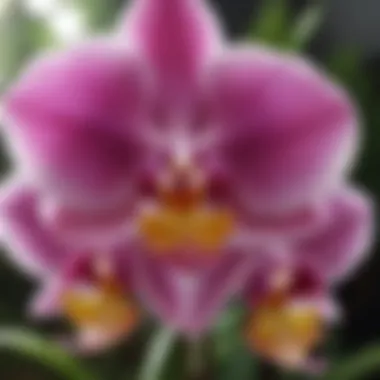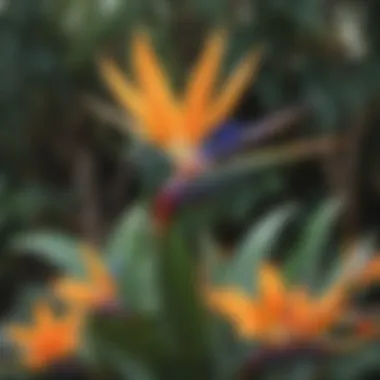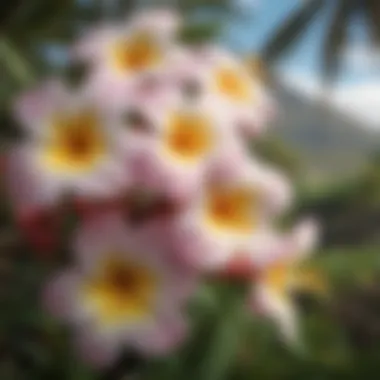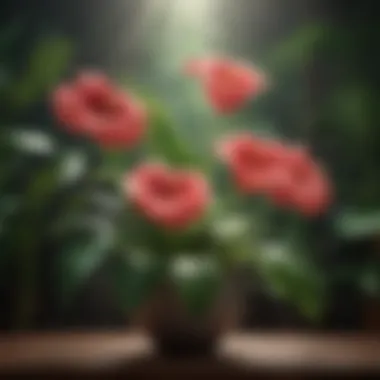Unveiling the Enchanting Diversity of Hawaiian Flora and Fauna


Plant Species Profile
Hawaii is endowed with a mesmerizing array of plant species that captivate enthusiasts and scholars alike. The plants native to this archipelago bloom in a profusion of colors, shapes, and fragrances, forming an integral part of Hawaiian culture and biodiversity. Understanding the unique characteristics and significance of these botanical wonders offers a profound glimpse into the ecological tapestry of Hawaii.
Floral Magnificence of Hawaii
Diversity and Cultural Significance
Hawaii's plant kingdom encompasses a diverse array of flora, ranging from the iconic hibiscus to the sacred taro plant. Each species holds a cultural and historical significance deeply rooted in the traditions and beliefs of the Hawaiian people. The vibrant colors and intricate patterns of these plants symbolize respect for nature and the harmony between humans and their environment.
Tropical Splendor and Volcanic Landscapes
The lush tropical forests and dynamic volcanic landscapes of Hawaii provide a fertile ground for a proliferation of plant life. From the emerald ferns that adorn the rainforest interiors to the hardy silverswords that dot the volcanic slopes, Hawaii's botanical diversity is a testament to the resilience and adaptability of native plant species.
Navigating the Botanical Paradise
Exploring Hawaii's botanical paradise unveils a tapestry of sights and scents that enrapture the senses. Trekking through the verdant valleys or strolling along the coastal cliffs offers a glimpse into the intricate ecosystem that sustains these plant species. Each step unveils a new discovery, from endemic species found nowhere else on Earth to the subtle nuances of plant interactions within the ecosystem.
Conservation Efforts and Ecological Resilience
Despite the allure of Hawaii's plant species, many face threats from invasive species, climate change, and habitat loss. Conservation efforts play a crucial role in preserving the unique biodiversity of Hawaii and safeguarding the future of indigenous plant populations. Understanding the challenges and initiatives in place sheds light on the complex interplay between conservation, biodiversity, and human activities.
Upholding Conservation Stewardship
Threats to Biodiversity
Invasive species pose a significant threat to native plant populations by outcompeting endemic species and disrupting fragile ecosystems. Climate change impacts, such as rising temperatures and altered rainfall patterns, further exacerbate the vulnerability of Hawaii's plant species. Habitat loss due to urbanization and agriculture also poses a looming threat to rare and endangered plants.
Mitigating Challenges Through Conservation
Various organizations and initiatives in Hawaii are dedicated to protecting the island's unique flora through conservation efforts. Reforestation projects, invasive species removal programs, and habitat restoration endeavors aim to revive and sustain native plant populations. Collaborative partnerships between conservation groups, government entities, and local communities are instrumental in safeguarding Hawaii's botanical heritage.
Celebrating Success and Sustaining Impact
Noteworthy success stories in plant conservation efforts demonstrate the tangible impact of dedicated conservation work. From the restoration of critically endangered species to the establishment of protected botanical reserves, these achievements underscore the value of collective action in preserving Hawaii's botanical legacy. Sustaining these successes requires long-term commitment, community involvement, and adaptive management strategies to navigate the ever-evolving landscape of conservation challenges.
Introduction to Hawaiian Flora
The Introduction to Hawaiian Flora sets the stage for a captivating journey through the botanical wonders of Hawaii. It serves as the gateway to exploring the rich biodiversity and cultural significance of Hawaiian plants and flowers. This section aims to provide readers with a comprehensive overview of the unique flora that thrives in the lush tropical forests and volcanic landscapes of Hawaii. By delving into the enchanting realm of Hawaiian botanicals, readers will gain a deeper appreciation for the ecological importance and aesthetic beauty of these plants. The Introduction to Hawaiian Flora not only showcases the variety of species found in Hawaii but also highlights the intricate connections between nature, culture, and conservation efforts.
Biodiversity Hotspot of Hawaii
Endemic Species
The Endemic Species in Hawaii represent a truly exceptional aspect of the island's biodiversity. These species are unique to Hawaii and are found nowhere else on Earth. Their presence highlights the evolutionary isolation of the Hawaiian Islands and underscores the fragile ecosystems that support these rare plants. Endemic Species play a crucial role in conservation efforts, emphasizing the need to protect their habitats from threats such as invasive species and habitat loss. The Endemic Species contribute to the overall biodiversity of Hawaii, showcasing nature's remarkable ability to adapt and thrive in diverse environments.


Importance of Isolation
The Importance of Isolation in Hawaii cannot be overstated when considering the evolution and survival of plant species. Isolation has played a fundamental role in shaping the distinct flora of the Hawaiian Islands, leading to the development of unique plant adaptations and specialized ecosystems. This isolation has resulted in the establishment of a biodiversity hotspot in Hawaii, attracting researchers, conservationists, and nature enthusiasts alike. Understanding the Importance of Isolation is key to appreciating the resilience and vulnerability of Hawaiian flora, highlighting the interconnectedness between geography, ecology, and biological diversity.
Cultural Significance
Traditional Uses
The Traditional Uses of Hawaiian plants and flowers are deeply rooted in the cultural practices and knowledge systems of indigenous communities. These traditional uses encompass a wide range of applications, including medicinal remedies, culinary ingredients, ceremonial offerings, and artisanal crafts. By exploring the Traditional Uses of Hawaiian botanicals, one gains insight into the ingenuity and resourcefulness of Native Hawaiian culture. The preservation of these traditional uses is vital for safeguarding indigenous knowledge and promoting sustainability in both environmental and cultural contexts.
Symbolism in Hawaiian Culture
Symbolism in Hawaiian Culture is intricately woven into the fabric of everyday life, with plants and flowers holding special meanings and significance. From lei-making traditions to spiritual beliefs, Hawaiian flora symbolizes concepts such as love, respect, hospitality, and connection to the land. Exploring the Symbolism in Hawaiian Culture reveals the depth of cultural wisdom embedded in botanical practices, fostering a greater appreciation for the intimate relationship between people and plants. By understanding the symbolism behind Hawaiian flora, one can engage more meaningfully with the traditions and heritage of the islands.
Native Plants of Hawaii
In the lush paradise of Hawaii, native plants play a crucial role in the ecosystem, showcasing a diverse range of flora that thrives in this unique environment. These plants are not only aesthetically pleasing but also serve significant ecological functions, contributing to the overall biodiversity of the Hawaiian islands. The distinctiveness of native Hawaiian plants lies in their adaptation to the local climate and soil conditions, making them resilient and well-suited to the region's tropical habitats. Furthermore, these plants hold immense cultural importance to the indigenous people of Hawaii, symbolizing heritage, tradition, and connection to the land.
Ohia Lehua
Legendary Mythology
Diving into the legendary mythology surrounding the Ohia Lehua plant unveils a rich tapestry of folklore and cultural significance. According to Hawaiian legend, the Ohia Lehua is associated with the tragic love story of Ohia and Lehua, symbolizing resilience, love, and the interconnectedness of nature. This captivating narrative adds a mystical charm to the plant, making it a popular choice for storytelling and cultural ceremonies. The unique feature of this mythology lies in its timeless appeal, transcending generations and capturing the hearts of those who hear its tale.
Distinctive Features
Exploring the distinctive features of the Ohia Lehua plant reveals a botanical wonder with striking characteristics. From its vibrant, red Lehua blossoms to its sturdy yet elegant ohia wood, this plant embodies resilience and beauty. The contrasting colors of the flower against the dark green leaves create a visual spectacle, attracting pollinators and admirers alike. The resilience of the Ohia Lehua against volcanic landscapes and changing climatic conditions further highlights its adaptability and strength, making it a valuable asset in Hawaii's native flora.
Hibiscus
State Flower of Hawaii
The Hibiscus, known as the state flower of Hawaii, holds a special place in the hearts of locals and visitors alike. Its vibrant blooms in shades of pink, red, yellow, and white dot the landscapes, adding a touch of tropical charm. Symbolizing delicate beauty and understated elegance, the Hibiscus embodies the spirit of aloha and hospitality, welcoming all who encounter its mesmerizing petals. Its presence in traditional leis, cultural festivities, and landscaping showcases its versatility and significance as a botanical icon of Hawaii.
Varieties and Colors
The rich diversity of hibiscus varieties in Hawaii offers a palette of colors for enthusiasts to admire. From single-petaled to double-petaled blooms, the hibiscus displays a wide range of shapes and sizes, each with its unique allure. Colors span a spectrum from fiery reds to cool blues, providing a visual feast for onlookers. This variety not only adds vibrancy to Hawaiian landscapes but also serves as a source of inspiration for artists, designers, and nature enthusiasts, celebrating the endless creativity of nature.
Ti Plant
Culinary and Medicinal Uses
The versatile Ti plant serves both practical and traditional purposes in Hawaiian culture, making it a valuable resource in daily life. Its leaves are utilized in cooking, imparting a subtle flavor to dishes and adding a pop of color to culinary creations. Additionally, the Ti plant holds medicinal properties, with extracts used in traditional healing practices to treat various ailments. This dual functionality underscores the plant's significance in Hawaiian heritage and sustainability, blending modern applications with age-old wisdom.
Cultural Practices


Embedded in Hawaiian traditions, the Ti plant plays a central role in cultural practices and rituals, symbolizing prosperity, protection, and spirituality. From lei making to ceremonial offerings, the Ti plant weaves its way into ceremonies and events, connecting individuals to their ancestors and the natural world. The plant's symbolic value extends beyond its physical attributes, embodying the essence of resilience and growth, reflecting the enduring spirit of Hawaiian culture amidst modernization and change.
Exotic Flowers of Hawaii
Exotic flowers in Hawaii play a pivotal role in showcasing the diverse botanical wonders of the region. These unique flowers add a touch of exotic beauty to Hawaii's landscape, attracting nature enthusiasts from around the globe. The vibrant colors and intricate shapes of exotic flowers contribute to the rich tapestry of Hawaiian flora. Exotic flowers are not only visually appealing but also hold cultural significance, often being used in traditional ceremonies and celebrations. Understanding the significance and characteristics of exotic flowers in Hawaii provides a deeper appreciation for the biodiversity of this enchanting destination.
Bird of Paradise
One of the most iconic flowers in Hawaii, the Bird of Paradise, captivates with its striking resemblance to a bird in flight. This unique feature not only adds to the allure of the flower but also symbolizes freedom and beauty. The Bird of Paradise's vibrant hues and intricate petal structure make it a popular choice for ornamental displays and garden landscapes, enhancing the tropical ambiance of Hawaii. Despite its beauty, the Bird of Paradise requires specific care and conditions to thrive, making it a challenging yet rewarding addition to any botanical collection.
Resemblance to a Bird
The striking resemblance of the Bird of Paradise to an actual bird in flight is its most distinctive feature. This characteristic not only sets it apart from other flowers but also highlights its elegance and grace. The bird-like appearance of the flower lends a sense of motion and liveliness to garden settings, creating a dynamic visual interest. While the resemblance to a bird adds a unique charm to the Bird of Paradise, it also requires careful maintenance to preserve its delicate structure and vibrant colors.
Symbol of Paradise
Being known as the 'Symbol of Paradise,' the Bird of Paradise embodies the essence of tropical bliss and exoticism. Its symbolic significance transcends mere aesthetics, representing paradise, freedom, and adventure. The flower's distinctive form and coloration evoke a sense of escape to a tropical haven, making it a popular choice for décor and landscaping. Incorporating the Bird of Paradise in floral arrangements not only adds a touch of luxury but also conveys a sense of sophistication and natural beauty.
Plumeria
Famous for its fragrant blooms and exquisite beauty, the Plumeria holds a special place in Hawaiian culture and traditions. The gentle fragrance of Plumeria flowers pervades the air, creating a sensory experience that is both relaxing and rejuvenating. In addition to their aromatic allure, Plumeria flowers are intricately linked to the art of lei-making, a revered Hawaiian tradition that celebrates nature's abundance and beauty. Understanding the significance of Plumeria in Hawaiian customs enhances the appreciation for this captivating flower.
Fragrant Blooms
The enchanting fragrance of Plumeria blooms is one of its most enchanting aspects, attracting not only humans but also pollinators like bees and butterflies. The sweet perfume of Plumeria flowers wafts through gardens and landscapes, adding a touch of natural elegance to the surroundings. The fragrant blooms of Plumeria are not only a sensory delight but also hold symbolic meanings of love, positivity, and tranquility, making them a popular choice for ornamental and aromatic purposes.
Lei-making Tradition
Central to Hawaiian cultural practices, the art of lei-making involves using Plumeria flowers to create intricate and colorful garlands. These floral leis symbolize love, respect, and friendship, serving as meaningful gifts exchanged during special occasions and celebrations. The delicate nature of Plumeria flowers makes them ideal for lei-making, as they lend a soft and graceful touch to the elaborate arrangements. Embracing the lei-making tradition with Plumeria flowers connects individuals with Hawaii's cultural heritage and natural abundance, fostering a sense of unity and appreciation.
Orchids
Renowned for their diverse species and striking beauty, orchids shine as exquisite floral gems in Hawaii's botanical landscape. The varied colors, shapes, and sizes of orchids present a visual feast for enthusiasts, showcasing nature's incredible artistry. From elegant phalaenopsis to vibrant dendrobiums, orchids adorn floral decorations and cultural festivities, reflecting Hawaii's rich floral heritage. Delving into the diversity and cultural significance of orchids reveals their role as symbols of luxury, grace, and refinement in Hawaiian traditions.
Diverse Species
The abundance of orchid species in Hawaii highlights the region's suitability for these ornate flowers to thrive. Each orchid species boasts unique characteristics in terms of color variations, petal arrangements, and blooming patterns, adding to the allure of these botanical treasures. Orchids range from vibrant hybrids to indigenous species, showcasing the adaptability of these exotic blooms in different ecosystems. Exploring the diverse species of orchids in Hawaii unveils a world of floral diversity and sophistication that captivates both enthusiasts and researchers alike.
Cultural Decorations
In Hawaiian culture, orchids hold special significance as decorative elements for ceremonies, events, and festivals. The intricate beauty of orchids adds a touch of elegance and grandeur to floral arrangements, symbolizing luxury and prosperity. Orchid garlands are often worn during traditional dances and rituals, embodying grace and refinement. The cultural prominence of orchids in Hawaiian decorations not only adds a visual appeal but also conveys deep-rooted traditions and values, showcasing the intricate relationship between nature and cultural expressions in Hawaii.
Environmental Conservation Efforts
The sector of environmental conservation efforts occupies a paramount position concerning the botanical realm, specifically within the context of Hawaiian plants and flowers. Considering the unique biodiversity native to Hawaii, preserving and safeguarding these delicate ecosystems becomes imperative to ensure their longevity and sustenance. Through a multifaceted approach encompassing various initiatives and strategies, environmental conservation efforts aim to mitigate threats posed by anthropogenic activities and external factors. By emphasizing sustainable practices, habitat restoration, and species protection, these efforts not only foster ecological resilience but also contribute to the cultural heritage intertwined with Hawaii's botanical paradises.


Challenges Facing Hawaiian Flora
Invasive Species
Invasive species represent a significant challenge confronting the Hawaiian flora, exerting detrimental impacts on the indigenous plant communities. Their rapid proliferation and aggressive nature disrupt the delicate ecological balance, outcompeting native species and altering the local ecosystems. This phenomenon contributes to the diminishment of biodiversity, threatening the very essence of Hawaii's unique flora. Despite their seeming resilience and adaptability, invasive species introduce an element of unpredictability and instability, posing a formidable obstacle to conservation efforts. The intricate web of interactions disrupted by these interlopers necessitates decisive action and meticulous monitoring to curtail their spread and mitigate their ecological repercussions.
Habitat Loss
Another pressing issue encumbering the Hawaiian flora is habitat loss, a consequence of urbanization, land development, and natural disasters. The shrinking of natural habitats deprives native plant species of their essential niches, diminishing their viability and survival prospects. Habitat loss not only exacerbates the vulnerability of endemic plants but also undermines the overall resilience of Hawaii's botanical landscapes. The irreplaceable loss of these unique ecosystems underscores the critical need for habitat restoration, conservation planning, and sustainable land management practices to reverse the tide of degradation and safeguard the intrinsic value of Hawaiian flora.
Protecting Endangered Plants
Conservation Initiatives
Efforts aimed at protecting endangered plants encompass a spectrum of conservation initiatives tailored to address the specific needs and vulnerabilities of at-risk species. These initiatives involve habitat restoration, seed banking, ex-situ conservation, and public awareness campaigns to garner support for plant protection. By mobilizing resources, expertise, and community engagement, conservation initiatives strive to enhance the resilience of endangered plants and prevent their extinction. The collaborative nature of these efforts underscores the importance of interdisciplinary cooperation and stakeholder involvement in ensuring the persistence of Hawaii's botanical treasures.
Role of Botanical Gardens
Botanical gardens play a pivotal role in the conservation and protection of endangered plants, serving as living repositories of genetic diversity and botanical knowledge. Their function extends beyond mere display to encompass research, education, and outreach programs aimed at raising awareness about endangered plant species. By serving as sanctuaries for threatened plants, botanical gardens contribute significantly to ex-situ conservation efforts, providing a safety net against the tide of extinction. The role of botanical gardens as custodians of biodiversity underscores their significance in the broader landscape of environmental conservation and underscores their indispensable contribution to preserving Hawaii's floral heritage.
Botanical Gardens in Hawaii
Botanical gardens in Hawaii encompass a rich tapestry of botanical wonders that offer a unique glimpse into the diverse flora of the islands. These gardens serve as living museums, showcasing a myriad of native and exotic plant species in carefully curated landscapes. Visitors to these tranquil havens can immerse themselves in the lush foliage, vibrant blooms, and fragrant blossoms that define Hawaii's botanical heritage.
Foster Botanical Garden
Historic Plant Collections
Foster Botanical Garden, home to an extensive collection of historic plant specimens, plays a pivotal role in preserving Hawaii's botanical legacy. The historic plant collections showcase a remarkable array of plant species that have cultural and historical significance to the islands. Visitors can marvel at rare specimens that date back decades, offering a glimpse into Hawaii's rich botanical past. The garden's focus on historic plant collections not only educates visitors on the unique flora of Hawaii but also highlights the importance of conservation efforts in safeguarding rare and endangered plant species.
Educational Programs
The educational programs offered at Foster Botanical Garden provide a deeper insight into the fascinating world of Hawaiian plants. Through guided tours, workshops, and interactive exhibits, visitors have the opportunity to learn about the ecological importance of native plant species and the role of botanical gardens in conservation efforts. These programs foster a greater appreciation for Hawaii's botanical heritage and raise awareness about the importance of preserving the island's unique flora for future generations.
Maui Nui Botanical Gardens
Native Plant Conservation
Maui Nui Botanical Gardens is dedicated to the conservation of native Hawaiian plant species, playing a crucial role in safeguarding the biodiversity of the islands. By focusing on native plant conservation, the garden aims to protect endangered species and restore vital habitats that support Hawaii's delicate ecosystems. Through propagation programs and cultivation initiatives, Maui Nui Botanical Gardens actively contributes to the preservation of rare and endemic plant species that are integral to the island's ecological balance.
Community Outreach
Community outreach programs at Maui Nui Botanical Gardens engage the local community in environmental conservation initiatives and promote a deeper connection to Hawaii's botanical heritage. Through educational workshops, volunteer opportunities, and outreach events, the garden fosters a sense of stewardship among residents and visitors alike. By actively involving the community in conservation efforts, Maui Nui Botanical Gardens enhances awareness about the importance of preserving Hawaii's native plant species and cultivating a sustainable relationship with the natural environment.
Limahuli Garden and Preserve
Preserving Native Ecosystems
Limahuli Garden and Preserve's focus on preserving native ecosystems reflects a commitment to maintaining the ecological integrity of Hawaii's landscapes. Through sustainable land management practices and habitat restoration projects, the garden protects critical habitats that support a diverse range of plant species. By emphasizing the conservation of native ecosystems, Limahuli Garden and Preserve creates a sanctuary for endemic plants to thrive and ensures the long-term sustainability of Hawaii's rich botanical heritage.
Research and Restoration Projects
Research and restoration projects at Limahuli Garden and Preserve aim to enhance scientific understanding of Hawaii's unique plant species and ecosystem dynamics. By conducting research on native plant populations and implementing habitat restoration strategies, the garden contributes valuable data to conservation initiatives across the islands. These projects not only support the preservation of endangered plant species but also pave the way for innovative conservation practices that benefit Hawaii's fragile ecosystems.







